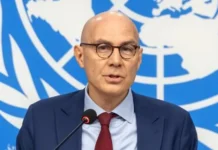By Kelly Were
The US Supreme Court has cleared the way for a major securities fraud lawsuit against technology behemoth Nvidia to move forward, dealing a blow to the company’s efforts to have the case thrown out. The court dismissed Nvidia’s appeal in a brief order, effectively upholding a previous ruling from the 9th Circuit Court of Appeals that had revived the class-action lawsuit filed by shareholders.
The legal battle stems from statements made by Nvidia between 2017 and 2018, during the peak of the cryptocurrency boom. Shareholders allege that the company knowingly misled investors by downplaying the significant portion of its revenue derived from sales of its graphics processing units (GPUs) to crypto miners. They claim that when the crypto market subsequently crashed, Nvidia’s stock price plummeted, causing substantial investor losses.
The plaintiffs’ case relies on expert analysis of internal company documents which, they argue, show Nvidia was aware of the revenue concentration. A lawyer for the shareholders declared, “This is a big win for corporate accountability. Investors will now have their day in court to prove Nvidia concealed the true source of its boom-era revenue.”
Nvidia had appealed to the Supreme Court, arguing that the shareholders had failed to meet the strict pleading standards for proving fraudulent intent, known as scienter, under the Private Securities Litigation Reform Act (PSLRA). However, the Supreme Court’s decision to dismiss the appeal as “improvidently granted” leaves the 9th Circuit’s investor-friendly ruling as the governing law.
A legal analyst noted, “The Supreme Court’s refusal to hear the case signals a reluctance to wade into fact-intensive securities disputes.” With the path to trial now open, the case enters a critical discovery phase, compelling Nvidia to open its internal records and emails to shareholder scrutiny. This development represents a significant legal vulnerability for the world-leading AI chipmaker as it contends with heightened regulatory and investor scrutiny.
WilmerHale Becomes Latest US Law Firm to Exit China
In a stark indicator of shifting economic tides, the elite American law firm WilmerHale is shuttering its Beijing office, becoming the latest in a steady exodus of US legal practices from China. The closure, announced late last year and to be completed by March 2025, marks the end of the firm’s physical presence in mainland China, following its withdrawal from Shanghai in 2021. WilmerHale is the twelfth major US firm to depart in the last eighteen months, a list that includes prestigious names like Skadden, Arps, Meagher, Slate & Flom and Paul, Weiss, Rifkind, Wharton & Garrison.
Industry observers point to a confluence of factors driving the retreat, including escalating geopolitical tensions between Washington and Beijing, heightened regulatory pressures from Chinese authorities, and a significantly cooled market for the cross-border mergers and acquisitions that were once the lifeblood of these offices. A legal industry consultant explained, “The golden era for US firms in China is over.
The risks and operational complexities now often outweigh the benefits.” The remaining US firms are largely consolidating their Asian operations in hubs like Hong Kong and Singapore, which offer a more familiar legal framework and remain gateways for international finance.
A statement from WilmerHale’s management characterised the move as a strategic recalibration, not a full retreat. The firm’s managing partner said, “This was a strategic, commercial decision. We remain committed to serving our global clients’ China-related needs from other offices in the region.” Nevertheless, the closure signals a profound transformation of the legal landscape.
The departure of so many US firms creates opportunities for Chinese domestic firms to capture more sophisticated local work, while the centre of gravity for international law in Asia continues to drift southwards, away from the mainland. This strategic pivot underscores the deepening commercial decoupling between the world’s two largest economies.
Trump Sceptical of 50-Year Mortgage Proposal
A controversial proposal to extend the American mortgage term to 50 years has been met with scepticism from former President Donald Trump, highlighting a deep political divide over how to tackle the nation’s escalating housing affordability crisis. The concept, floated by housing advocates and under discussion at the Federal Housing Finance Agency (FHFA), aims to lower monthly payments for borrowers but has drawn criticism for potentially creating a generation of perpetual debtors.
Proponents, including FHFA Director Sandra Pulte, argue that in an era of soaring interest rates and record-high home prices, radical solutions are necessary. By stretching a loan over five decades, monthly payments could be reduced by an estimated $400, making homeownership theoretically accessible to more families. “We must consider every tool available.
For some families, getting a foot in the door is the immediate priority,” Pulte stated. However, the trade-off is a staggering increase in the total interest paid over the life of the loan, and the slow build-up of home equity. Donald Trump recently weighed in, minimising the proposal’s impact: “It’s no big deal. It lowers the payment, sure, but you’re paying for twice as long. It’s not the revolution they say it is.”
Consumer protection groups have been far more critical, labelling the idea as dangerously predatory. A prominent consumer advocate argued, “This is a predatory proposal that would trap low-income buyers in a cycle of debt and build equity at a snail’s pace.” They contend that it treats a symptom, high monthly payments, while ignoring the underlying disease of a critical shortage of affordable homes.
Furthermore, implementing such a scheme would likely require amendments to the Dodd-Frank financial reform law, setting the stage for a fierce legislative battle. As the 2024 election cycle heats up, the debate over 50-year mortgages encapsulates a broader philosophical conflict: whether to make debt more manageable or to focus on making housing itself more affordable.
COP30 Summit Opens with Dire Warnings on Climate Finance
The United Nations climate change conference, COP30, commenced under the dense canopy of the Amazon rainforest in Belém, Brazil, with leaders issuing dire warnings and urgent pleas for trillions of dollars in climate finance. The summit, held from 6th to 21st November, is being framed as the “Implementation COP,” with a central focus on finalising a roadmap to mobilise $1.3 trillion annually and compelling nations to submit more ambitious national climate plans.
The location of the conference in the Amazon, a vital carbon sink facing unprecedented deforestation, serves as a potent backdrop for discussions. The UN Secretary-General set a stark tone in his opening address, stating, “The pipeline of climate action is clear, but it is frozen by a lack of finance. Belém must be the COP that turns on the tap.”
A key agenda item is the operationalisation of the Loss and Damage fund, designed to help vulnerable countries recover from climate impacts they did little to cause. A lead negotiator for a small island state expressed the frustration of many developing nations, saying, “Empty promises are a death sentence for our nations. We need to see the money flow, now.”
This conference is the critical mid-point in the “Baku-Belém roadmap,” a two-year process to accelerate action following the stocktake at COP28 in Dubai. A climate analyst at the summit explained, “The ‘Baku-Belém roadmap’ is the crucial bridge from the ambitious targets set in Dubai to the concrete plans required in 2025.”
With a new UN report warning that current pledges still put the world on track for a catastrophic 2.3-2.5°C of warming, the pressure is on major economies to not only increase their financial contributions but also to table more stringent emissions reduction targets. The outcome of this summit in the heart of the Amazon will be a definitive test of the international community’s political will to avert a full-blown climate catastrophe.
Controversial Lockdown Critic Confirmed as NIH Director
Dr. Jayanta Bhattacharya, an epidemiologist from Kolkata who gained prominence as a vocal critic of mainstream COVID-19 pandemic policies, has been confirmed as the director of the US National Institutes of Health (NIH). His confirmation by the Senate on 25th March marks a historic moment, making him the first Indian-American to lead the world’s largest public funder of biomedical research, a agency with an annual budget exceeding $45 billion.
Dr. Bhattacharya, a professor at Stanford University, was one of the authors of the Great Barrington Declaration, which in 2020 argued against broad lockdowns in favour of a “focused protection” strategy for the most vulnerable. This history made his nomination contentious, drawing both strong support and fierce opposition.
A public health advocate commented, “His appointment is divisive. While his academic record is strong, his stance on lockdowns raised questions about his alignment with public health orthodoxy.” However, a colleague from Stanford defended him, saying, “Jayanta is a brilliant, independent thinker. He is not afraid to challenge consensus, which is precisely what the NIH needs to foster innovation.”
In his first address, the new director outlined priorities that break from the pandemic-era focus. He stated, “My focus is on safeguarding American biomedical research while tackling the root causes of our most pervasive health challenges: heart disease, diabetes, and obesity.” He plans to implement a ban on foreign subcontracting for certain sensitive research areas, a move aimed at protecting US intellectual property and national security.
His leadership is expected to steer the NIH towards a greater emphasis on preventative medicine for chronic conditions, a shift that will redefine the agency’s direction for years to come and test the ability of a controversial figure to lead the nation’s premier health institution.
Bill Gates Predicts AI Will Halve Child Mortality by 2045
Philanthropist and Microsoft co-founder Bill Gates has forecast a new revolution in child survival, predicting that artificial intelligence will be instrumental in halving the number of children who die before their fifth birthday by the year 2045. This ambitious projection, made during a keynote address on global health, builds on the dramatic progress already made over the past two decades, which saw annual child mortality fall from 10 million in 2000 to under 5 million today.
Gates credited this previous success to concerted investments in vaccines, nutrition, and maternal health. Now, he argues, AI is poised to be the next great leap forward. “AI is the most transformative tool in global health since the advent of modern vaccines,” Gates stated. “Its potential to analyse complex data and predict health outcomes will save millions of young lives.”
To back this vision, the Bill & Melinda Gates Foundation has announced a pledge of $912 million to develop AI-powered tools, which could range from algorithms that interpret ultrasound images in rural clinics to predictive models that identify children at highest risk of malnutrition or disease.
The global health community has responded with cautious optimism. A global health expert noted, “The promise is immense, particularly for diagnostic tools in low-resource clinics. But the digital divide must be bridged to ensure these tools reach the poorest communities.” Others warn that technology alone is insufficient.
A critic of tech-centric solutions argued, “Technology is not a silver bullet. Without parallel investments in health systems, training, and clean water, AI will have limited impact.” Despite these concerns, Gates’s prediction underscores a fundamental shift in how cutting-edge technology is being deployed to solve humanity’s most persistent problems, setting a bold new target for the future of global health equity.
India Launches Home-Grown Battery in Green Energy Leap
India has taken a giant leap towards energy self-sufficiency with the launch of its first home-grown large-scale vanadium flow battery, a breakthrough that coincides with the nation’s solar manufacturing capacity hitting a monumental high. State-owned power giant NTPC unveiled the 3 MWh Vanadium Redox Flow Battery (VRFB) at its NETRA research centre on 11th November, a critical step in solving the storage challenge that accompanies renewable energy.
The dual announcements highlight India’s comprehensive strategy to dominate the clean energy sector. While the country’s solar module manufacturing capacity is projected to reach 125 GW by the end of the year, enabling massive domestic solar farm deployment, the new vanadium battery provides a durable and scalable solution to store that energy.
The NTPC Chairman described the launch as a “watershed moment for India’s energy independence. The VRFB is a safe, long-lasting solution to store solar energy for use at night.” Unlike the more common lithium-ion batteries, VRFBs are non-flammable, have a longer lifespan, and do not degrade over time, making them ideal for grid-scale storage.
An energy analyst explained the strategic significance: “Vanadium flow batteries are ideal for grid-scale storage. Coupled with the domestic solar manufacturing boom, this makes India a serious player in the global clean energy race.” This move also reduces India’s strategic vulnerability to supply chain disruptions for lithium, which is largely controlled by China. An industry representative added that the “125 GW solar capacity milestone will not only meet domestic demand but also position India as a major exporter of solar components.” Together, these developments signal India’s determined pivot from a energy importer to a powerhouse in both renewable generation and storage technology.
UN Report Finds World Still Far Off Track on Climate Goals
A sobering report from the United Nations has dashed hopes that recent climate promises would put the world on a path to safety, revealing that new national pledges have only marginally reduced the projected global temperature rise. The UN Environment Programme’s (UNEP) annual Emissions Gap Report, published on 4th November, concludes that even if all current climate pledges are fulfilled, the planet is still headed for a catastrophic warming of between 2.3 and 2.5 degrees Celsius above pre-industrial levels.
The report acts as a stark scientific reality check for governments gathering at the COP30 climate summit in Belém. It finds that the latest round of Nationally Determined Contributions (NDCs)—the climate action plans each country submits under the Paris Agreement—have been woefully inadequate. The UNEP Executive Director did not mince words, stating, “The world is sprinting in slow motion.
These minor adjustments are like applying a bandage to a bullet wound. The emissions gap remains a chasm.” If only current policies are considered, the outlook is even grimmer, with warming projected to hit 2.8°C. A climate scientist involved in the report warned, “A 2.3°C world is not a slightly worse version of today. It is a planet of escalating superstorms, famine, and irreversible tipping points.”
To get on track to meet the Paris Agreement’s 1.5°C goal, the report states that global emissions must be slashed by 35% to 55% by 2035. This requires an immediate and unprecedented acceleration of action. A lead author of the report emphasised, “The data is unequivocal. We have a narrow window to course-correct, and it requires transformational action not incremental action.” The findings heap pressure on wealthy nations to not only meet their own ambitious targets but also to deliver the massive financial support required for developing countries to transition to clean energy and adapt to a changing climate.
Sean Paul Pledges $50,000 to Hurricane Relief in Jamaica
International music icon Sean Paul has stepped up for his homeland, launching a generous matching fund to support Jamaica’s recovery from the destructive force of Hurricane Melissa. The dancehall superstar announced on 30th October that his foundation would match public donations dollar-for-dollar, pledging up to $50,000 to provide critical aid to affected communities across the island.
The hurricane, which struck Jamaica with ferocious winds and torrential rain, caused widespread flooding, destroyed homes, and crippled infrastructure. In a video message, Sean Paul, born Sean Paul Ryan Francis Henriques in Kingston, made an emotional appeal to his global fanbase. “Jamaica is my heart. When my people suffer, I suffer with them,” he said. “I am calling on my fans worldwide to join me in giving whatever they can. Every dollar will be doubled to help families rebuild.” The funds are destined for on-the-ground organisations providing immediate relief such as clean water, medical supplies, and materials for repairing damaged houses.
A local relief coordinator praised the initiative, noting, “Sean Paul’s generosity is a catalyst. This matching fund will inspire others to give and will directly translate into food, shelter, and hope for those who have lost everything.” The effort exemplifies the powerful role celebrities can play in mobilising resources and international attention during a humanitarian crisis.
Fans on social media have widely applauded the move, with one commenting, “This is what true star power looks like, using your platform to make a real difference on the ground.” As Jamaica begins the long process of rebuilding, contributions amplified by the star’s personal commitment will provide a vital lifeline for countless families.
Ancient Skulls Pulled from Thames Reveal Prehistoric Rituals
A trove of ancient human skulls, unearthed from the mud of the River Thames, is offering archaeologists a haunting glimpse into the ritual world of Britain’s Bronze and Iron Age inhabitants. The discoveries, made throughout 2025, consist of several skulls dating back as far as 4,000 years, found without any other skeletal remains, pointing towards a deliberate and spiritually significant practice of watery deposition.
The River Thames has long been a rich source of historical artefacts, from prehistoric weaponry to Roman treasures. However, the concentration of human skulls from this specific era suggests the river held a profound sacred significance. The lead archaeologist on the project explained, “The Thames was a spiritual thoroughfare for ancient Britons.
These skulls were deliberately placed in the water, likely as votive offerings to their gods.” This practice aligns with findings across Europe, where bogs, lakes, and rivers were seen as liminal portals to the divine. A forensic anthropologist studying the skulls added, “The condition of the bones suggests they were curated for a time before deposition. This was a meaningful, ritualistic act, not casual disposal.”
Theories suggest the skulls could be those of revered ancestors, war trophies, or even human sacrifices offered to appease water deities for a good harvest or victory in battle. A history professor not involved in the dig commented, “This discovery reinforces a pan-European pattern of watery deposition.
Rivers were the liminal spaces between the world of the living and the world of the gods.” While the exact meaning may never be fully known, the discovery powerfully underscores how prehistoric communities perceived their landscape as alive with spiritual force, using the timeless flow of the Thames to communicate with powers beyond their understanding.



















